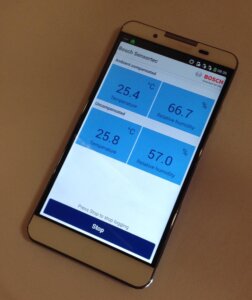 According to Eric Mounier, of Yole Développement, over the past 15 years, the MEMS market has grown from 15M units to 5B units, driven first by the automotive market to comply with safety regulations, and then by consumer electronics due to the added functionalities in smartphones that require accelerometers, gyroscopes, and geo-magnetic sensors. Mounier says that the next big thing could be automotive again as we enter the “combo phase” where sensors provide mixed capabilities like pressure and temperature, optical and image sensor with LEDs, or three sensors combined (temperature, humidity, and gas for example,) for different sensations that mimic the five senses. He sees gas sensors as the next success for the MEMS industry.
According to Eric Mounier, of Yole Développement, over the past 15 years, the MEMS market has grown from 15M units to 5B units, driven first by the automotive market to comply with safety regulations, and then by consumer electronics due to the added functionalities in smartphones that require accelerometers, gyroscopes, and geo-magnetic sensors. Mounier says that the next big thing could be automotive again as we enter the “combo phase” where sensors provide mixed capabilities like pressure and temperature, optical and image sensor with LEDs, or three sensors combined (temperature, humidity, and gas for example,) for different sensations that mimic the five senses. He sees gas sensors as the next success for the MEMS industry.
Mounier puts Bosch as one of the top five leaders in the MEMS market, second to ST Microelectronics over all. Jérémie Bouchaud, IHS said Bosch dominates the automotive sensor market. In 2005, the company launched its wholly-owned subsidiary, Bosch Sensortec, leveraging its automotive leadership into the consumer space. Now automotive is benefiting from the consumer market. According to Bouchaud, serving both markets benefits economies of scale, filling the fab and increasing competitiveness for sensors that are similar in automotive and consumer electronics. If this is the case, than Bosch is on a trajectory for continued success.
In an interview at the European MEMS Summit, Stefan Finkbeiner, General Manager and CEO, Bosch Sensortec, talked to 3DInCites about the company’s strategy in the MEMS market, and how they see the future panning out in Internet of Things (IoT) applications.
Bosch’s Back Story
Not only is Bosch a leader in MEMS, it is a pioneer in the industry. As previously mentioned, the company started with technology development in the automotive market and rode that first wave successfully. Finkbeiner said the second wave was mobile devices, during which Bosch Sensortec’s business grew thanks to smartphone applications. IoT-enabled applications are expected to become the third wave, and the company is well positioned to take it on because they have full access to Bosch technologies. They are all produced on the same manufacturing lines, using the same processes thus increasing the capacity.
Therein lies one key to Bosch’s success. While smaller companies take 5-10 years to ramp a new product, Finkbeiner said Bosch operates on a 2-year product development cycle. They can do this by building on pre-developed technologies. Also, rather than monolithically integrating the MEMS with the CMOS device, which requires MEMS devices to be redeveloped to stay in sync with the CMOS scaling roadmap, Bosch uses a 2-chip approach. Decoupling the MEMS device, which is developed in the µm scale, from the CMOS, which is in nanometer scale, makes it easier to move forward, explained Finkbeiner. Qualification is easier when it can be done sequentially. Incidentally, Bosch has adopted 3D TSV stacking technology to integrate MEMS and IC devices.
Bosch and the IoT
After 20 years in existence, 75% of the population now has access to the Internet, such that now it is a prerequisite for new devices to be able to connect to it. Smart sensors connect to the Internet and exchange data with intelligent databases and data mining applications. However, noted Finkbeiner, this will only work and commercially take off if there is an overall benefit for the end user; a use case or a business case. One good example of a use case is the indoor air-quality gas sensor – an integrated environmental unit capable of measuring barometric air pressure, temperature, humidity and gas / indoor air quality – which is especially useful in Smart Home and Smart Building applications to improve air-quality and at the same time save energy. Sensors will only be implemented if they provide a convincing use case.
“It’s not just about the technology, it’s also about business models,” he explained. “Then a broad product portfolio is key. For the device manufacturer, it’s much easier to have one single supplier to integrate the whole sensor system rather than 10 different suppliers with individual sensors.”
The highest synergies are in the process technologies, such as etching. “We are in the lead developing technologies. Our automotive branch has already had capacity in place to produce high quality products in volume,” he said. “Having this background was helpful even though consumer electronics serves different markets in different regions.” Today, some technologies that Bosch Sensortec develop go back to the automotive market, which is why the automotive branch at Bosch is benefiting from Bosch Sensortec right now.
While sensor-based automotive products differ in many ways from sensors targeting consumer products, it still made sense for Bosch to get into the consumer electronics model. Finkbeiner explained that the automotive market is very predictable, because it’s driven mainly by law-enforced safety requirements such as tire pressure systems and airbags, which are easy to plan for and therefore less volatile. It’s less risky to add a more volatile market like sensors for consumer electronics on top of that.
Finkbeiner also noted that use cases and consequently the technological requirements in consumer electronics are increasing, so that’s another area where being able to leverage experience from automotive sensors is an advantage. Reliability is another important area where Bosch Sensortec benefits from its “automotive mother”: The lifetime of a sensor-based system in consumer electronics is only 2-3 years, whereas automotive is 10 years, with spare parts needing to be available for another 10.
Bosch Sensortec in Action
There’s no doubt that Bosch Sensortec is working on some pretty cool applications for environmental sensors, as well as gaming applications. They showcased two at the Summit.
One demonstrator was an absolute orientation sensor that combines sensors and sensor fusion algorithms in a system-in-package. Comprising an acceleration sensor, gyroscope, magnetometer, 32-bit microcontroller and sensor fusion algorithms, this device is targeted for robotics, drones, Industry 4.0 (Europe’s integration of man and machine), IoT-enabled applications, indoor navigation, and augmented reality.

The second demonstrator was an environmental sensor that combines pressure, temperature, humidity, and gas to determine indoor air quality and also altitude to improve accuracy in daily activity tracking, and promote a healthy lifestyle.
Does Finkbeiner think the wearables market will be as sure a thing as the smartphone market? “I don’t think it’s a higher risk. It’s coming a bit slower than the smartphone, but there are many more (IoT-enabled) applications for smartphones that are a natural extension of what’s coming out of consumer electronics (wearables),” he said, adding that for example, environmental sensors make sense in wearables, smartphones, and the smart home.
On the other hand, he said he doesn’t think the volumes will be so high for IoT-enabled applications that there will be a problem with capacity. Rather, it will develop market-by-market; application-by-application. The most important thing to consider is the use case. “Nobody really cares about what’s inside. The end customers are buying the functionality – or the specific use case,” he explained. “Customers want more functionality. We are more of a solutions provider.” In companies developing devices for smart homes, there aren’t MEMS experts. MEMS manufacturers have to make it easy, by adding intelligence on top of the sensor level to deliver module integration. A gas sensor, for example, isn’t just electronics, it’s mechanics, chemistry, and microfluidics as well.
One question that has been at the forefront of everyone’s mind in IoT is the one of security and privacy. Whether we’re talking about hackers taking over control of an automobile via its Internet connectivity, or having access to sensor data from wearables or smart home devices, this has become a growing issue that must be addressed. Finkbeiner said that he sees safety is more of a concern than privacy of say, fitness data. Smart home sensors can – if not properly secured – provide data on when you are home or away, giving potential thieves a window into opportune break-in times.
While Finkbeiner explained that as sensors just deliver raw data, this issue must be addressed at the system-level, Bosch takes the issue seriously and takes measures to ensure their sensors can’t be easily hacked. “As soon as the device is wireless, it is something to be concerned with and we take it seriously,” he said.
All in all, Finkbeiner is confident that Bosch’s experience in consumer and automotive sensor business combined with its internal IoT expertise from the various business units is opening up new ways for future-oriented sensor technologies. ~ F.v.T.























